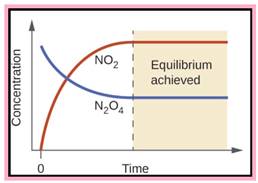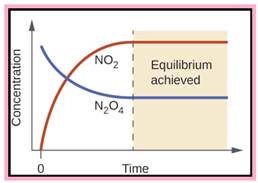
Consider the reaction
Interpretation:
The graph representing the change in the concentrations of the reactant and product at equilibrium conditions for the given reaction has to be drawn and the term dynamic equilibrium has to be explained.
Concept introduction:
Dynamic equilibrium: When the rate of forward and reverse reactions of a chemical reaction occurs with the same rate, the system is said to be at dynamic equilibrium.
Answer to Problem 14.1QP
The graph representing the given reaction at dynamic equilibrium,

Figure 1
At dynamic equilibrium the reaction is not ceased instead both the forward and reverse reactions occurs with the same rate.
Explanation of Solution
The Graph representing the given reaction is given in figure

Figure
In a chemical reaction when the forward and the reverse reaction has the same rate the system is said to be at dynamic equilibrium. At dynamic equilibrium the reaction is not ceased instead both the reactions occurs with the same rate.
The graph representing the change in the concentrations of the reactant and product at equilibrium conditions for the given reaction was drawn and the term dynamic equilibrium has been explained.
Want to see more full solutions like this?
Chapter 14 Solutions
Bundle: General Chemistry, Loose-leaf Version, 11th + OWLv2, 4 terms (24 months) Printed Access Card
- Suppose a reaction has the equilibrium constant K = 1.3 108. What does the magnitude of this constant tell you about the relative concentrations of products and reactants that will be present once equilibrium is reached? Is this reaction likely to be a good source of the products?arrow_forwardAt room temperature, the equilibrium constant Kc for the reaction 2 NO(g) ⇌ N2(g) + O2(g) is 1.4 × 1030. Is this reaction product-favored or reactant-favored? Explain your answer. In the atmosphere at room temperature the concentration of N2 is 0.33 mol/L, and the concentration of O2 is about 25% of that value. Calculate the equilibrium concentration of NO in the atmosphere produced by the reaction of N2 and O2. How does this affect your answer to Question 11?arrow_forward12.103 Methanol, CH3OH, can be produced by the reaction of CO with H2, with the liberation of heat. All species in the reaction are gaseous. What effect will each of the following have on the equilibrium concentration of CO? (a) Pressure is increased, (b) volume of the reaction container is decreased, (c) heat is added, (d) the concentration of CO is increased, (e) some methanol is removed from the container, and (f) H2 is added.arrow_forward
- . What does it mean to say that a state of chemical or physical equilibrium is dynamic?arrow_forwardA 4.72-g sample of methanol (CH3OH) was placed in an otherwise empty 1.00-L flask and heated to 250.C to vaporize the methanol. Over time, the methanol vapor decomposed by the following reaction: CH3OH(g)CO(g)+2H2(g) After the system has reached equilibrium, a tiny hole is drilled in the side of the flask allowing gaseous compounds to effuse out of the flask. Measurements of the effusing gas show that it contains 33.0 times as much H2(g) as CH3OH(g). Calculate K for this reaction at 250.C.arrow_forwardWrite an equation for an equilibrium system that would lead to the following expressions (ac) for K. (a) K=(Pco)2 (PH2)5(PC2H6)(PH2O)2 (b) K=(PNH3)4 (PO2)5(PNO)4 (PH2O)6 (c) K=[ ClO3 ]2 [ Mn2+ ]2(Pcl2)[ MNO4 ]2 [ H+ ]4 ; liquid water is a productarrow_forward
- A solution is prepared by dissolving 0.050 mol of diiodocyclohexane, C5H10I2, in the solvent CCl4.The total solution volume is 1.00 L When the reaction C6H10I2 C6H10 + I2 has come to equilibrium at 35 C, the concentration of I2 is 0.035 mol/L. (a) What are the concentrations of C6H10I2 and C6H10 at equilibrium? (b) Calculate Kc, the equilibrium constant.arrow_forwardIn Section 13.1 of your text, it is mentioned that equilibrium is reached in a closed system. What is meant by the term closed system. and why is it necessary to have a closed system in order for a system to reach equilibrium? Explain why equilibrium is not reached in an open system.arrow_forward. Explain what it means that a reaction has reached a state of chemical equilibrium. Explain why equilibrium is a dynamic state: Does a reaction really “stop” when the system reaches a state of equilibrium? Explain why, once a chemical system has reached equilibrium, the concentrations of all reactants remain constant with time. Why does this constancy of concentration not contradict our picture of equilibrium as being dynamic? What happens to the rates of the forward and reverse reactions as a system proceeds to equilibrium from a starting point where only reactants are present?arrow_forward
- What is the law of mass action? Is it true that the value of K depends on the amounts of reactants and products mixed together initially? Explain. Is it true that reactions with large equilibrium constant values are very fast? Explain. There is only one value of the equilibrium constant for a particular system at a particular temperature, but there is an infinite number of equilibrium positions. Explain.arrow_forwardAt 2300 K the equilibrium constant for the formation of NO(g) is 1.7 103. N2(g) + O2(g) 2 NO(g) (a) Analysis shows that the concentrations of N2 and O2 are both 0.25 M, and that of NO is 0.0042 M under certain conditions. Is the system at equilibrium? (b) If the system is not at equilibrium, in which direction does the reaction proceed? (c) When the system is at equilibrium, what are the equilibrium concentrations?arrow_forwardWrite a chemical equation for an equilibrium system that would lead to the following expressions (ad) for K. (a) K=(PH2S)2 (PO2)3(PSO2)2 (PH2O)2 (b) K=(PF2)1/2 (PI2)1/2PIF (c) K=[ Cl ]2(Pcl2)[ Br ]2 (d) K=(PNO)2 (PH2O)4 [ Cu2+ ]3[ NO3 ]2 [ H+ ]8arrow_forward
 General Chemistry - Standalone book (MindTap Cour...ChemistryISBN:9781305580343Author:Steven D. Gammon, Ebbing, Darrell Ebbing, Steven D., Darrell; Gammon, Darrell Ebbing; Steven D. Gammon, Darrell D.; Gammon, Ebbing; Steven D. Gammon; DarrellPublisher:Cengage Learning
General Chemistry - Standalone book (MindTap Cour...ChemistryISBN:9781305580343Author:Steven D. Gammon, Ebbing, Darrell Ebbing, Steven D., Darrell; Gammon, Darrell Ebbing; Steven D. Gammon, Darrell D.; Gammon, Ebbing; Steven D. Gammon; DarrellPublisher:Cengage Learning Chemistry: The Molecular ScienceChemistryISBN:9781285199047Author:John W. Moore, Conrad L. StanitskiPublisher:Cengage Learning
Chemistry: The Molecular ScienceChemistryISBN:9781285199047Author:John W. Moore, Conrad L. StanitskiPublisher:Cengage Learning Chemistry: Principles and PracticeChemistryISBN:9780534420123Author:Daniel L. Reger, Scott R. Goode, David W. Ball, Edward MercerPublisher:Cengage Learning
Chemistry: Principles and PracticeChemistryISBN:9780534420123Author:Daniel L. Reger, Scott R. Goode, David W. Ball, Edward MercerPublisher:Cengage Learning General, Organic, and Biological ChemistryChemistryISBN:9781285853918Author:H. Stephen StokerPublisher:Cengage LearningChemistry: Matter and ChangeChemistryISBN:9780078746376Author:Dinah Zike, Laurel Dingrando, Nicholas Hainen, Cheryl WistromPublisher:Glencoe/McGraw-Hill School Pub Co
General, Organic, and Biological ChemistryChemistryISBN:9781285853918Author:H. Stephen StokerPublisher:Cengage LearningChemistry: Matter and ChangeChemistryISBN:9780078746376Author:Dinah Zike, Laurel Dingrando, Nicholas Hainen, Cheryl WistromPublisher:Glencoe/McGraw-Hill School Pub Co Chemistry for Engineering StudentsChemistryISBN:9781337398909Author:Lawrence S. Brown, Tom HolmePublisher:Cengage Learning
Chemistry for Engineering StudentsChemistryISBN:9781337398909Author:Lawrence S. Brown, Tom HolmePublisher:Cengage Learning





